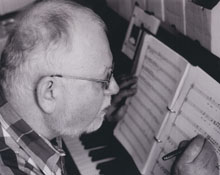|

The music of Julian Dawes
MALCOLM MILLER was at the
first performance of 'Eleven Hebrew Folksongs'
There were two world premières and two first performances in the concert devoted to the music of Julian Dawes that regaled a capacity audience at Lauderdale House, Highgate, London UK, on 23 February 2006. The programme featured three remarkable song cycles and two instrumental works that well displayed Dawes' intriguing, individual style, adding a rich perspective on a recent creative output that has seen such major works as The Death of Moses (reviewed in M&V), the oratorio Ruth, and I never saw a Butterfly, children's poems for Terezin for children's voices and piano, premièred in 2005.
Julian Dawes has composed music for major theatrical productions from Sydney Australia to the Bristol Old Vic, with music for several Brecht plays held by the Brecht Estate in Berlin. His dramatic music is reflected particularly in the bold, powerful ambience of his song cycles, such as Songs of Ashes, settings of fifteen poems about the Holocaust by the Polish poet Jerzy Ficowski (reviewed in M&V), and the three song cycles performed in this recital. Dawes' musical idiom draws on a wide range of sources, including the English modernism of Rubbra and Howells, film and theatre music from Weill to Walton, and spiced with elements of Mediterranean and Jewish folksong in which he has a continuing interest.

Julian Dawes
|
The Songs of Samuel Hanagid received a beautiful account by the accomplished tenor Robert Brody, who gave the world première in 2001 (reviewed in M&V), accompanied by the composer. On this occasion one could especially appreciate the vivid contrasts amongst the eight songs from poems by Samuel Hanagid (993-1056), the Medieval Spanish-Jewish statesman and scholar and poet, with the Hebrew texts always clearly projected. Soaring melodic lines and somewhat detached piano accompaniments were spiced by hints of word-painting, evocations of arhythmic plainchant contrasted by exciting rhythms and incisive dissonances that recalled at times both Musorgsky and Kurt Weill.
The detached ambience in the first song, 'Prison', was in the split between a folk like melody and slow chordal texture, whilst the faster brief piano textures of 'The Master', formed an interlude before the sombre chords and bass ostinato of 'War'. Especially characteristic of Dawes' style are the piquant dissonant waltz textures which here infused 'The Root' with a bitter-sweet flavour, while relentless winding melody over processional chords coloured 'Take Heart', sinewy lines in 'The Two Cries', and the scampering 'Complaint'; a thrilling high C on the word 'Yomam' (Day) at the climax of the final 'Winter Wine Song' concluded the cycle with panache.
Continue >>
Copyright © 6 May 2006
Malcolm Miller, London UK

|

